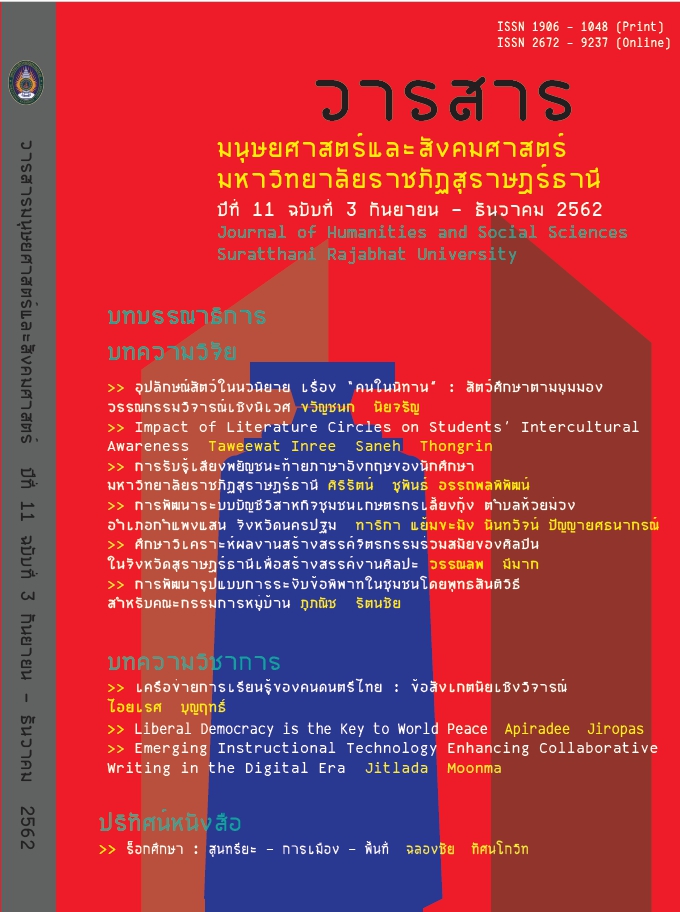IMPACT OF LITERATURE CIRCLES ON EFL UNDERGRATUATE STUDENTS’ INTERCULTUAL AWARENESS
Main Article Content
Abstract
This study aimed to investigate the impact of literature circles on undergraduate students’ intercultural awareness. The participants were 26 students, and this qualitative study employed semi-structured interview and journal to collect the data. The results showed that reading children’s
literature integrated into literature circles could help the undergraduate students increase their intercultural awareness. In addition, students could develop not only their own cultural awareness but awareness for different cultures as well.
4
Article Details

This work is licensed under a Creative Commons Attribution-NonCommercial-NoDerivatives 4.0 International License.
All published manuscripts have been verified by peer-peer professors in the fields of humanities and social sciences. Reprinting of the article must be authorized by the editorial staff.
References
Baker, W. (2012). From Cultural Awareness to Intercultural Awareness: Culture in ELT, ELT Journal Volume, 66(1), 62-70.
Bastos, M. & Sá, H.A. (2015). Pathways to Teacher Education for Intercultural Communicative Competence: Teachers’ Perceptions.
The Language Learning Journal, 43(2), 131–147.
Bickley, C., Rossiter, M. J., & Abbott, M. L. (2014). Intercultural Communicative Competence: Beliefs and Practices of Adult English as a Second Language Instructors. Alberta Journal of Educational Research, 60(1), 135-160.
Bishop, J. (2018). Iguana Boy Saves the World with a Triple Cheese Pizza. London: Hodder and Stoughton.
Bista, K. (2012). Multicultural Literature for Children and Young Adults. The Educational Forum, 76, 317-325.
Byram, M. (1997). Teaching and Assessing Intercultural Communicative Competence. Clevedon: Multilingual Matters, Ltd.
Chen, G.M. & Starosta, W.J. (2005). Foundations of Intercultural Communication. New York; University Press of America.
Daniels, H. (2002). Literature Circles: Voice and Choice in Book Clubs and Reading Groups. 2nd Edition. Portland, ME: Stenhouse.
Farris, P.J., Nelson, P.A., & L’Allier, S. (2015). Using Literature Circles with English Language Learners at the Middle Level. Middle School
Journal, 38(4), 38-42.
Gómez, L.F. (2014). Relational Teaching: A Way to Foster EFL Learners’ Intercultural communicative Competence through Literary Short Stories. Colombian Applied Linguistics Journal, 16(2), 135-150.
Herrera, L.J.P. & Kidwell, T. (2018). Literature Circles 2.0: Updating a Classic Strategy for the 21st Century. Multicultural Education, 17-22.
Iwai, Y. (2015). Using Multicultural Children’s Literature to Teach Diverse Perspectives. Kappa Delta Pi Record, 51(2), 81-86.
Mian, Z. (2019). Planet Omar Accidental Trouble Magnet. London: Hodder.
Osorio, S.L. (2018). Multicultural Literature as a Classroom Tool. Multicultural Perspectives, 20(1), 47-52.
Rasinski, T. & Padak, N. ( 2004). Effective Reading Strategies: Teaching Children Who Find Reading Difficult. 3rd Edition. New Jersey:
Pearson Education, Inc
.
Smith, A. M. (2018). Hari and His Electric Feet. Edinburgh: Barrington Stoke Ltd.
Strickland, D.S., Galda, L.,& Cullinan, B.E. (2004). Language Arts: Learning and Teaching. Victoria: Wadsworth Publishing.
Ur, P. (2012). A Course in English Language Teaching (2nd edition). Cambridge; Cambridge University Press.
Young, C., & Mohr, K.A.J. (2018). Exploring Factors that Influence Quality Literature Circles. Literacy Research and Instruction, 57(1), 44-58.
Zhang, R. & Steele, D. (2012). Improving Intercultural Awareness: A Challenging Task for Japan. Social and Behavioral Sciences, 47, 52-63.


